William Howie was the builder of the tenement on the south side of Nithsdale Road, which was completed and occupied in 1878. We know this as the deeds record the feuing of the land by William Stevenson, the developer of Strathbungo, to William Howie & Sons, on the understanding they would, within a year, raise a tenement of shops and houses.

Excerpt from deeds of a Nithsdale Road flat, describing feuing of land to William Howie & Son.
At that time the street was known as Matilda Place, and the tenement was named Matida Terrace. It is now simply known by the odd numbers on Nithsdale Road, and includes establishments such as The Bungo Bar & Kitchen, formerly the Fotheringay, and Zinfandel, formerly Samuel Dow’s.
The building was Category B listed in 1989 .
Later 19th century late Georgian-style 3-storey terrace. Unusually long rank of identical single window bays, centre part (nos 33-41) very shallow recessed, public house at W end, shops and canted corner bay at E.
However the identity of William Howie had remained a mystery until I was contacted from Australia by his great great grandson, Adrian Howie. We can now add William to the list of Builders of Strathbungo. The architect remains unknown.
William Howie
William was born in Glasgow on 12 January 1831 to John Howie and Elesebeth McDonald. He was one of seven children, and was living on Edinburgh Road in 1841. Family lore is that the Howies were related to the Howies of Loch Goin, the famous covenanters who lived on the remote farm south of Eaglesham. A monument erected to John Howie (1735-1793), who documented the history of the covenanters, stands beside the farm on a remote spot amongst the turbines of Whitelee wind farm.
William married Christina Black of Rothesay in 1849, a marriage that resulted in three boys and ten girls, all but one of whom reached adulthood. By 1861 he was living at Stirrats Court, Blythswood, working as a stone cutter and mason.
By 1871 the family was at 38 (West) Campbell Street, and he employed 20 masons and 10 labourers. Unfortunately we do not know which buildings he constructed during this time, but two of his sons, John (b. 3 Feb 1850) and Archibald (b. 3 Dec 1854), trained as masons and worked for him. Unusually none of them appear to have been members of the Incorporation of Masons of Glasgow. John spent a couple of years working in Montreal in the 1870s before returning to Glasgow and marrying.
Later the firm moved to Calder Street on the southside, close to Cathcart Road, and in 1875 William made a brief appearance in the press, although for the wrong reasons. He was fined 45 shillings (or 30 days in jail) for cruelty to horses on the public highway, which were suffering sores on their backs .
in 1874 the firm purchased the land for construction of Matilda Terrace. An 1877 photo of Queens Park exists with the building under construction in the background.
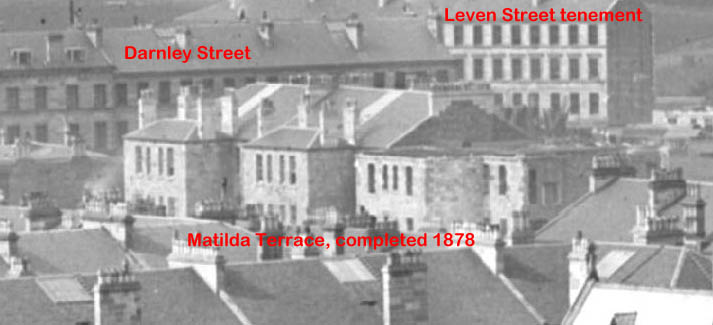
Matilda Terrace under construction, c 1877. Part of a photograph by George Washington Wilson.
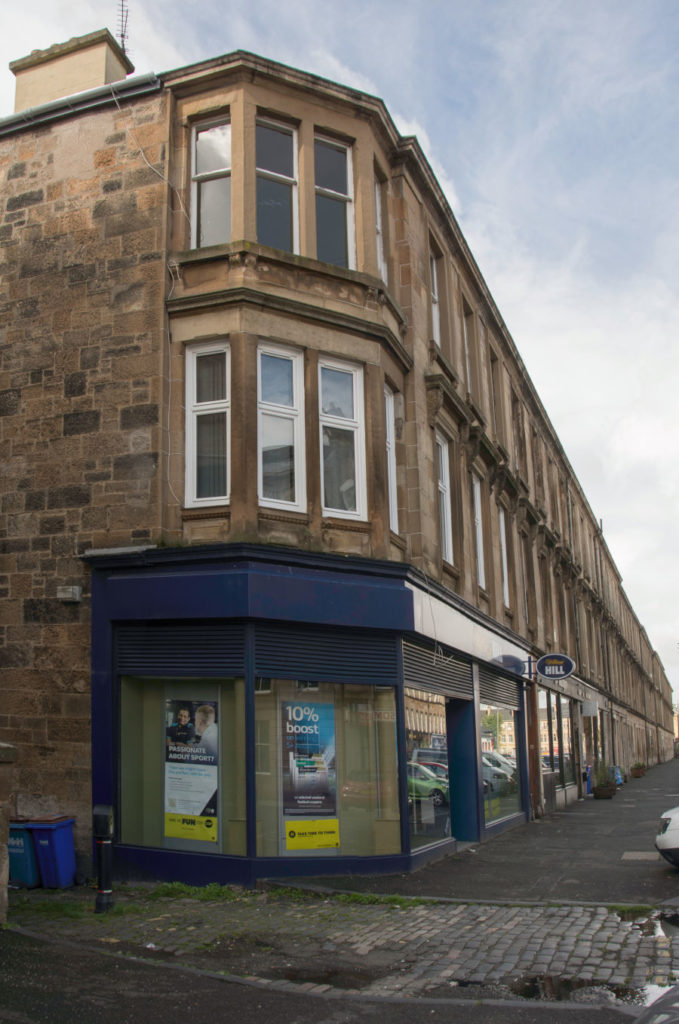
Matilda Terrace, Nithsdale Road, September 2022, with canted corner bay.

An ealier view of the same shop. H Bradford, 11 Nithsdale Road, Sep 1935. Credit: Glasgow City Archives, Ref D-CA8/2200
Disaster
The tenement was completed in 1878, but on 2nd October disaster struck when the City of Glasgow Bank closed its doors and promptly collapsed, in a financial scandal that caused recession in Glasgow, ruined the bank’s shareholders, and bankrupted many Glasgow businesses . The incident is also covered elsewhere on BygoneBungo. The Howies were not shareholders, and depositors’ money was protected after the collapse, so the exact cause of their financial problems is unclear, but the collapse ruined them too. The building firm, and William himself, were declared bankrupt within two weeks of the collapse.
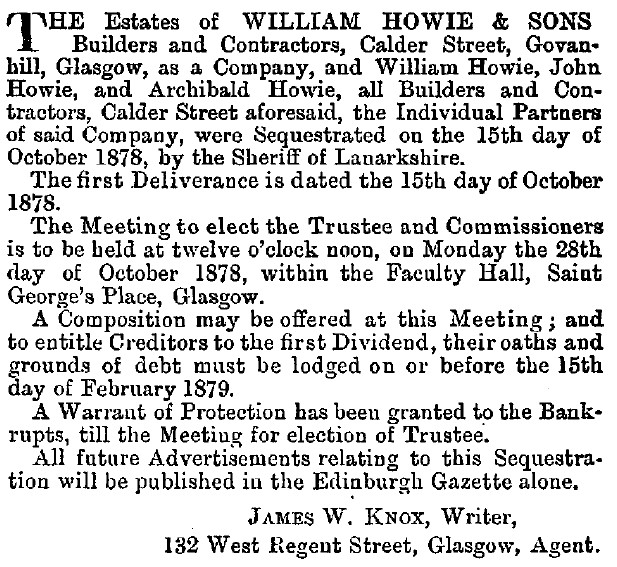
Bankruptcy of the Howies announced in the Edinburgh Gazette of 18 Oct 1878. Source: The Gazette
William died at Calder Street two years later on 1 May 1880, aged only 49. His estate was worth a paltry £106.
The Howie sons
William’s sons John and Archibald were partners in the business and so were also bankrupted, but their lives took a rather different course; they fled the country to start a new life. Whether this was after settling their debts or to avoid them we do not know, but within five months of the bank’s failure they were away.
Archibald’s girlfriend Janet had become pregnant around August 1878, and the couple were hastily married on 11 March 1879 at her father’s house, Alma Cottage in Shawlands. Yet only 10 days later, Archibald was leaving Britain without her for a new life in Australia.
Passage to Australia
John and Archibald departed from Plymouth on 21 March 1879, accompanied by their 16 year old sister Mary, John’s wife Agnes and his infant son William . Presumably Janet stayed behind as giving birth on a ship at sea carried significant risk.
‘The ship Samuel Plimsoll, 1444 tons. Captain Boaden, chartered by the Agent-General for New South Wales, sailed from Plymouth for Sydney on March 21 with 465 emigrants under the supervision of Mr. Pringle Hughes as surgeon-superintendent, with Miss Jones in charge of the single women’
Samuel Plimsoll

The Samuel Plimsoll at Sydney. Credit: State Library of South Australia
The Samuel Plimsoll was a fast trader built in Aberdeen for the Aberdeen White Star Line and launched in 1873. She was named in honour of the politican and social reformer (and inventor of the Plimsoll line) who attended her launch. In her career she made at least 20 trips to Australia & New Zealand, often carrying emigrants .
On this occasion the ship sailed from Plymouth on 21 March, and arrived at Sydney on 11 June 1879, where her passengers were placed in quarantine; they were only officially recorded as having arrived on 30 June. One female passenger, Elizabeth Allbon, kept a diary of the trip, and gave birth on board. Her account was published in No Privacy for Writing – Shipboard Diaries 1852 – 1879 .

Samuel Plimsoll passenger list, showing John Howie’s family. The newly-wed Archibald was listed separately under “Single men”. Credit: NSW State Archives
Quarantine
During the quarantine period the passengers were kept at North Head Quarantine Station, Manly. Many passengers carved initials or brief messages on the rocks there. John Howie, being a mason, went one better, and left two carefully crafted carvings which have been the subject of academic study .
The first, 3m up a rock face, is clearly the work of a skilled mason. He drew a star above the word “Ship” and under the ship’s name Samuel Plimsoll he listed five of the ship’s senior staff by name; the captain, chief officer, second officer, purser and matron. Beneath these he carved 462 (unnamed) emigrants, their date of arrival, and his own name.
The numbers are significant. 465 emigrants set out, twelve died en route, and three were born on board, making 456 to land at the quarantine station. But add the senior officers listed and you get 461, not 462. Strangely missing from the carving is the ship’s surgeon, Pringle Hughes, implying John was not impressed by the man. One suggestion is that he had been caught with a couple of the single female passengers.
Also missing and unmentioned, though no doubt in his thoughts, was his own infant son William, one of the twelve who died during the trip.
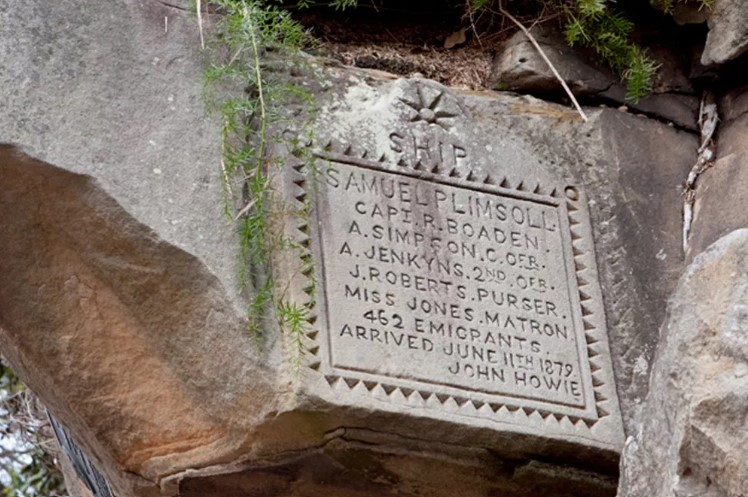
John Howie’s carving of details of their arrival on the Samuel Plimsoll. Credit: Ursula Frederick
The second carving is a less formal shield-like carving in relief, bearing five names, Mary Howie, A. Howie, Wm Fairfoull, Andw Reid and John Howie. Mary is his young sister, while A. Howie may stand for his wife Agnes, his brother Archibald, or both. There was an Andrew Reid on board, with wife and children, and a William (recorded as Fairfood or Fairfoot) with his wife. Both were young labourers from Scotland. Thus it is possible the plaque refers to the male heads of families, apart from the single Mary, and thus represents the arrival of 10 different individuals.
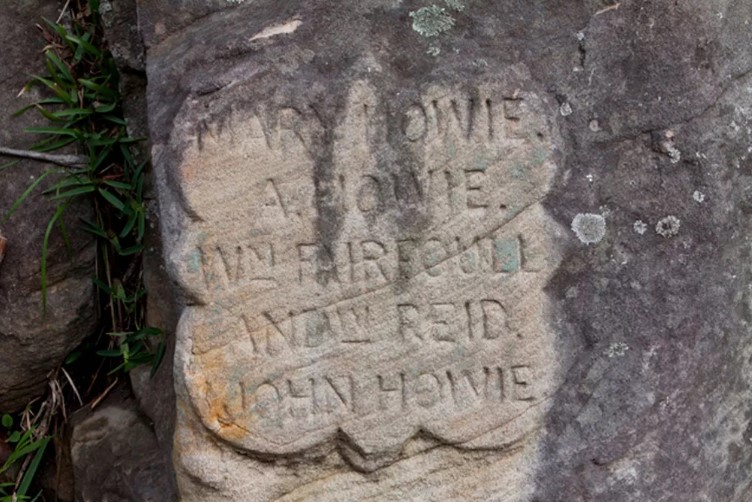
John Howie’s second inscription under quarantine. Credit: Ursula Frederick
Meanwhile Archibald’s wife Janet gave birth at Alma Cottage to their only child, another Archibald, on 12 May 1879. She finally followed her husband to Australia, arriving with their baby on the Clyde two years later on 23 June 1881.
William’s widow Christina also left Glasgow for Australia in 1881, but for reasons unknown moved to Bodalla, some way south of Sydney and her family, where she died in 1886.
Success in Sydney
John started out as the Clerk of Works at the Colonial Architects Office under James Barnett. He set up in business with his brother Archie as Howie Brothers and won major contracts for public works including a naval store on Garden Island, the general post office in Martin Place, additions to the Australian Museum, and the City vegetable markets. John was the foreman mason during the construction of Sydney General Post Office. Word even got back to their homeland via a tour by a Mr Muir, reported in the Aberdeen Press & Journal, December 1889 .
Referring to the most imposing pile of buildings in the southern hemisphere, now being erected for the Sydney Post Office (estimated cost £400,000), Mr Muir mentioned that the foreman mason was Mr John Howie, son of the late William Howie, builder, Glasgow, and a man holding a good position in the city.
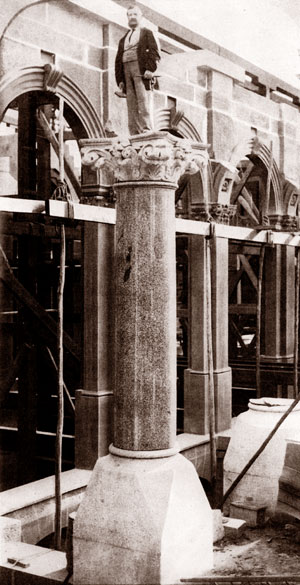
Master stonemason and clerk-of-works, thought to be John Howie, stands in a rather precarious position atop a carved pillar during construction of the Pitt St wing of the General Post Office, Sydney, c.1882. Credit: photo-web.com.au
The Glaswegian brothers’ reputation as builders and masons grew rapidly. In 1897 and 1899 they worked on two galleries for the Art Gallery of NSW and the central lobby completed in 1902. In 1906 Howie won the contract for the grand sandstone wing of the Mitchell Library which still holds in its collection a silver trowel and mallet awarded to the Howie Brothers for ‘faithful work and straightforward dealing’ .
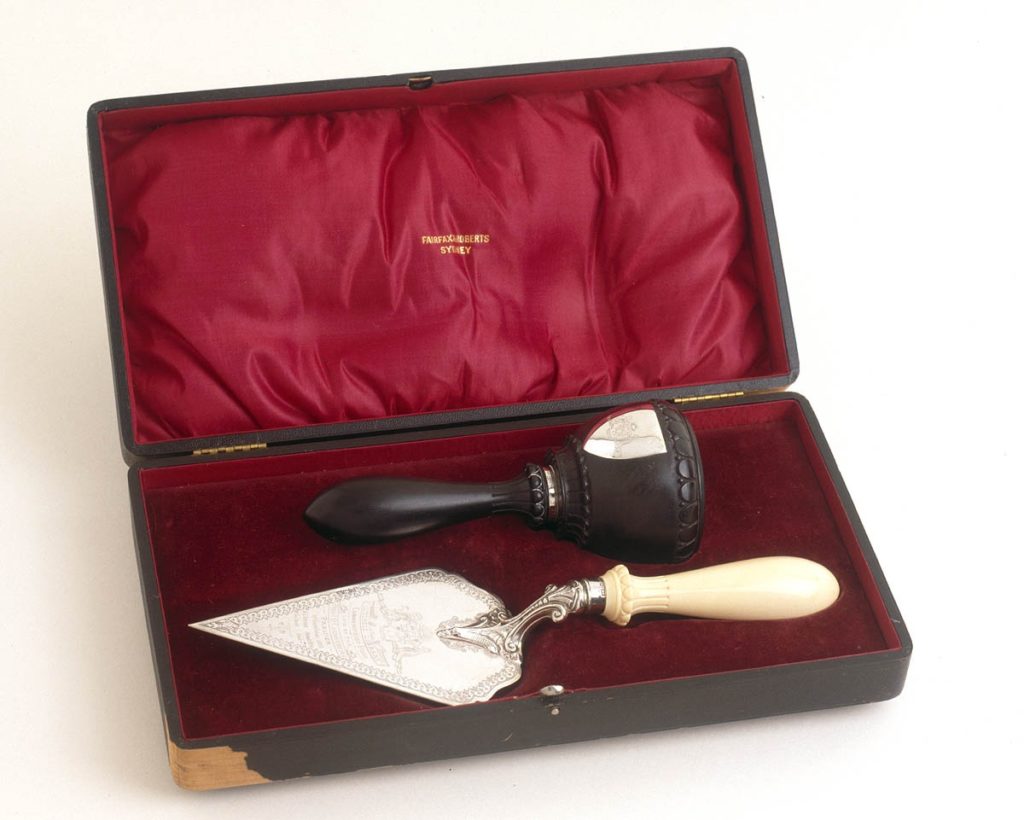
Silver trowel and ebony mallet in presentation box used to lay Foundation Stone of the Mitchell Library 11 September 1906. Engraved Howie Bros, Contractor. Credit: State Library of New South Wales
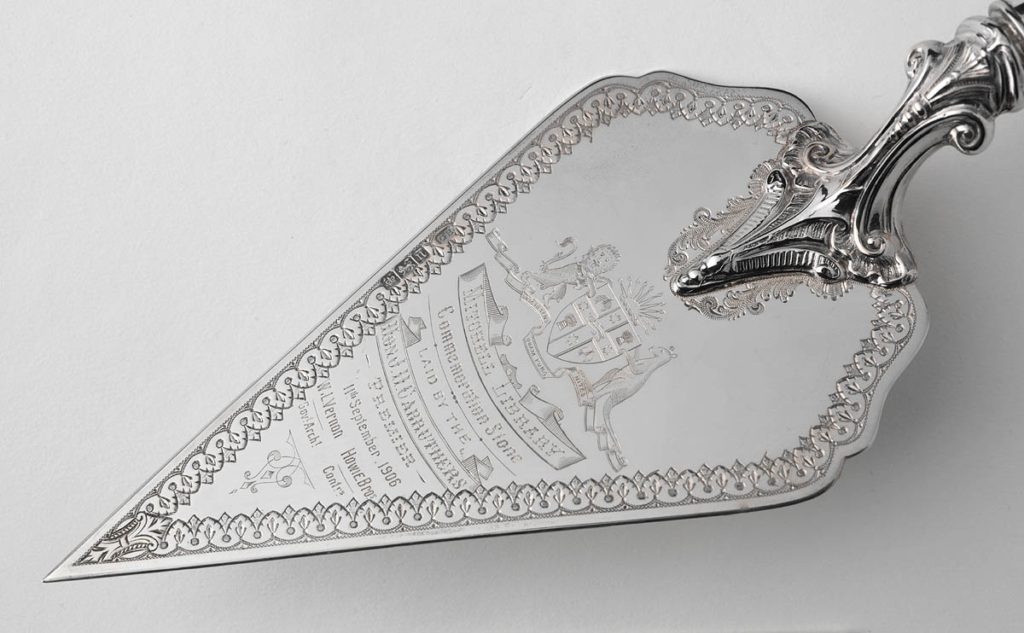
Detail of trowel, engraved Howie Bros, Contractors. Possibly the one referred to in the text. Credit: State Library of New South Wales
Sometime in the 1890s the brothers split their business, though they co-operated on projects such as the Mitchell Wing of the NSW State Library (no relation to Glasgow’s own Mitchell Library). John continued as John Howie & Sons with his two sons John and William and son-in-law David Pollok Park, who had married his daughter Elizabeth . David was the son of a stonemason from Rutherglen who had also been badly affected by the bank failure and who had emigrated to Australia.
John retired in 1910 and in 1912 built a house for himself and his wife Agnes (nee Hislop) in the Blue Mountains at Katoomba. He named it Cathkin Braes, supposedly after her birthplace, but given she was born in St Quivox this seems unlikely . It is considered one of the finest heritage houses in the district, and sits only a short distance from the famous Three Sisters viewpoint. John served as mayor of Katoomba, and when he died in 1917 flags there were flown at half mast . His sons continued the business successfully, a notable example of the firm’s work being the Bondi Surf Pavillion.
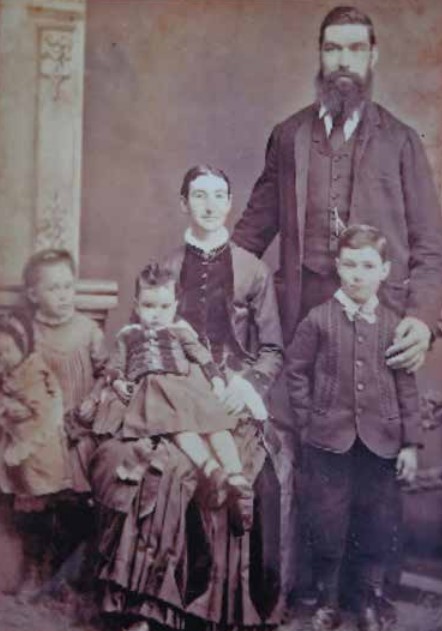
John Howie with his wife Agnes, and three children Elizabeth, John & William c. 1886/7. Credit: SteelReid Studio

John Howie’s home, Cathkin Braes. Credit: SteelReid Studio
Politics
Archibald continued as Howie Bros, then Howie, Brown & Moffat, finally Howie, Moffat & Co Ltd, and his son, also Archibald (the one born in Shawlands after his father had sailed for Australia) took over the company. The latter also entered politics, served as Lord Mayor of Sydney in 1936 & 7 and was knighted for his services in 1939. Archibald died at Drummoyne in 1923, and his son Sir Archibald in 1943, at his home in Hunters Hill.

Alderman (later Sir) Archibald Howie, Mayor of Sydney 1936-7. Credit: City of Sydney Archives
The Fergusons
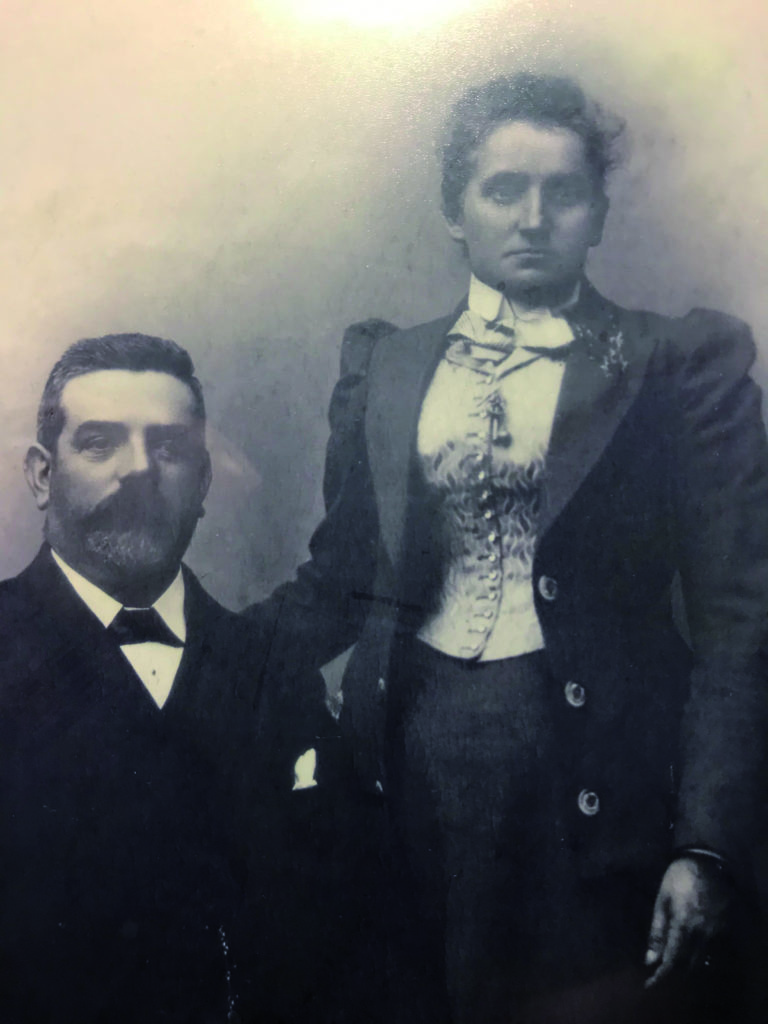
Archibald and Janet Howie, c 1890s. Credit: Adrian Howie
Archibald Howie’s wife Janet was the daughter of Andrew Ferguson, a southside dairyman carter and contractor. Andrew was born in East Kilbride, and married Agnes Kerr in Coylton, Ayr in 1854. They moved to Glasgow, living at Alma Place or Alma Cottage in Shawlands where Janet married Archibald days before his departure to Australia. Andrew appears to have worked for a dairy in Crossmyloof. By 1891 Andrew and Agnes were at 1 Nithsdale Street (now 65 Nithsdale Street) and he had a yard in March Street. By 1901 at the age of 70 he was widowed and living with his son at 736 Pollokshaws Road in Strathbungo.
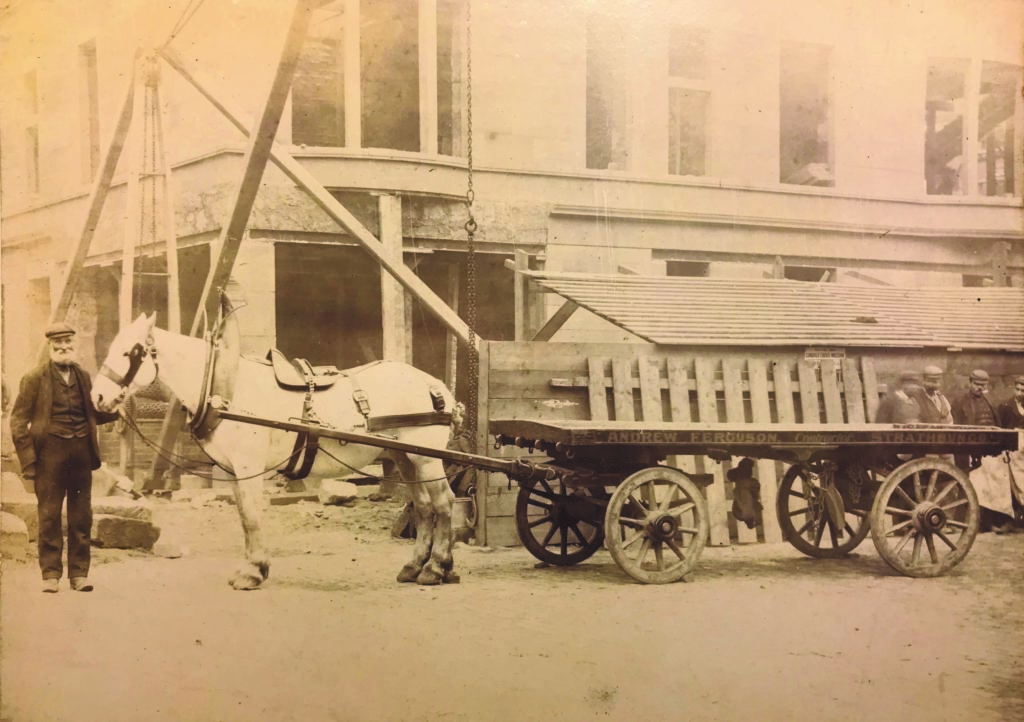
The inscription on the cart reads “Andrew Ferguson, contractor, Strathbungo”. Outside an unidentified tenement under construction. Credit: Adrian Howie
I have failed to identify the building under construction. The poster reads Gorbals Cross Mission; if it was in the Gorbals it may be long gone.
Epilogue
And the Samuel Plimsoll? It ended up at the bottom of Fremantle Harbour – you can explore the wreck if you wish .
References
{3557955:H73Q8D7W};{3557955:9VFBHG5N};{3557955:G7RERABA};{3557955:CTMJVX56},{3557955:NTBKY4R3};{3557955:TR7FEZZL};{3557955:LPJIN57P};{3557955:YQR3K9I3};{3557955:U73ZEACB};{3557955:ZMC2F73Z};{3557955:5CSA9UWY};{3557955:4HJ8SZKT};{3557955:5CSA9UWY};{3557955:V9KMM9G3};{3557955:89BXAIH8}
vancouver
default
asc
no
3635
%7B%22status%22%3A%22success%22%2C%22updateneeded%22%3Afalse%2C%22instance%22%3A%22zotpress-45e4d711eca4fdeef95932ce8d809971%22%2C%22meta%22%3A%7B%22request_last%22%3A0%2C%22request_next%22%3A0%2C%22used_cache%22%3Atrue%7D%2C%22data%22%3A%5B%7B%22key%22%3A%22V9KMM9G3%22%2C%22library%22%3A%7B%22id%22%3A3557955%7D%2C%22meta%22%3A%7B%22creatorSummary%22%3A%22Howie%22%2C%22parsedDate%22%3A%222022-08-20%22%2C%22numChildren%22%3A0%7D%2C%22bib%22%3A%22%3Cdiv%20class%3D%5C%22csl-bib-body%5C%22%20style%3D%5C%22line-height%3A%201.35%3B%20%5C%22%3E%5Cn%20%20%3Cdiv%20class%3D%5C%22csl-entry%5C%22%20style%3D%5C%22clear%3A%20left%3B%20%5C%22%3E%5Cn%20%20%20%20%3Cdiv%20class%3D%5C%22csl-left-margin%5C%22%20style%3D%5C%22float%3A%20left%3B%20padding-right%3A%200.5em%3B%20text-align%3A%20right%3B%20width%3A%201em%3B%5C%22%3E1.%3C%5C%2Fdiv%3E%3Cdiv%20class%3D%5C%22csl-right-inline%5C%22%20style%3D%5C%22margin%3A%200%20.4em%200%201.5em%3B%5C%22%3EHowie%20A.%20Howies%3A%20Personal%20Communication.%202022.%3C%5C%2Fdiv%3E%5Cn%20%20%20%3C%5C%2Fdiv%3E%5Cn%3C%5C%2Fdiv%3E%22%2C%22data%22%3A%7B%22itemType%22%3A%22email%22%2C%22subject%22%3A%22Howies%3A%20Personal%20Communication%22%2C%22creators%22%3A%5B%7B%22creatorType%22%3A%22author%22%2C%22firstName%22%3A%22Adrian%22%2C%22lastName%22%3A%22Howie%22%7D%5D%2C%22abstractNote%22%3A%22%22%2C%22date%22%3A%2220%5C%2F8%5C%2F2022%22%2C%22url%22%3A%22%22%2C%22language%22%3A%22%22%2C%22collections%22%3A%5B%22CAR6MXPM%22%5D%2C%22dateModified%22%3A%222022-08-23T07%3A19%3A16Z%22%7D%7D%2C%7B%22key%22%3A%22H73Q8D7W%22%2C%22library%22%3A%7B%22id%22%3A3557955%7D%2C%22meta%22%3A%7B%22numChildren%22%3A1%7D%2C%22bib%22%3A%22%3Cdiv%20class%3D%5C%22csl-bib-body%5C%22%20style%3D%5C%22line-height%3A%201.35%3B%20%5C%22%3E%5Cn%20%20%3Cdiv%20class%3D%5C%22csl-entry%5C%22%20style%3D%5C%22clear%3A%20left%3B%20%5C%22%3E%5Cn%20%20%20%20%3Cdiv%20class%3D%5C%22csl-left-margin%5C%22%20style%3D%5C%22float%3A%20left%3B%20padding-right%3A%200.5em%3B%20text-align%3A%20right%3B%20width%3A%201em%3B%5C%22%3E1.%3C%5C%2Fdiv%3E%3Cdiv%20class%3D%5C%22csl-right-inline%5C%22%20style%3D%5C%22margin%3A%200%20.4em%200%201.5em%3B%5C%22%3E11-69%20%28ODD%20NOS%29%20NITHSDALE%20ROAD%20%28LB32393%29%20%5BInternet%5D.%20%5Bcited%202022%20Aug%2019%5D.%20Available%20from%3A%20%3Ca%20href%3D%27http%3A%5C%2F%5C%2Fportal.historicenvironment.scot%5C%2Fdesignation%5C%2FLB32393%27%3Ehttp%3A%5C%2F%5C%2Fportal.historicenvironment.scot%5C%2Fdesignation%5C%2FLB32393%3C%5C%2Fa%3E%3C%5C%2Fdiv%3E%5Cn%20%20%3C%5C%2Fdiv%3E%5Cn%3C%5C%2Fdiv%3E%22%2C%22data%22%3A%7B%22itemType%22%3A%22webpage%22%2C%22title%22%3A%2211-69%20%28ODD%20NOS%29%20NITHSDALE%20ROAD%20%28LB32393%29%22%2C%22creators%22%3A%5B%5D%2C%22abstractNote%22%3A%22%22%2C%22date%22%3A%22%22%2C%22url%22%3A%22http%3A%5C%2F%5C%2Fportal.historicenvironment.scot%5C%2Fdesignation%5C%2FLB32393%22%2C%22language%22%3A%22%22%2C%22collections%22%3A%5B%22CAR6MXPM%22%5D%2C%22dateModified%22%3A%222022-08-19T16%3A00%3A22Z%22%7D%7D%2C%7B%22key%22%3A%22G7RERABA%22%2C%22library%22%3A%7B%22id%22%3A3557955%7D%2C%22meta%22%3A%7B%22creatorSummary%22%3A%22Button%20and%20Knott%22%2C%22parsedDate%22%3A%222015%22%2C%22numChildren%22%3A0%7D%2C%22bib%22%3A%22%3Cdiv%20class%3D%5C%22csl-bib-body%5C%22%20style%3D%5C%22line-height%3A%201.35%3B%20%5C%22%3E%5Cn%20%20%3Cdiv%20class%3D%5C%22csl-entry%5C%22%20style%3D%5C%22clear%3A%20left%3B%20%5C%22%3E%5Cn%20%20%20%20%3Cdiv%20class%3D%5C%22csl-left-margin%5C%22%20style%3D%5C%22float%3A%20left%3B%20padding-right%3A%200.5em%3B%20text-align%3A%20right%3B%20width%3A%201em%3B%5C%22%3E1.%3C%5C%2Fdiv%3E%3Cdiv%20class%3D%5C%22csl-right-inline%5C%22%20style%3D%5C%22margin%3A%200%20.4em%200%201.5em%3B%5C%22%3EButton%20R%2C%20Knott%20S.%20Desperate%20adventurers%20and%20men%20of%20straw%3A%20the%20failure%20of%20City%20of%20Glasgow%20Bank%20and%20its%20enduring%20impact%20on%20the%20UK%20banking%20system.%20Bank%20of%20England%20Quarterly%20Review%20%5BInternet%5D.%202015%20Q1%3B23%26%23x2013%3B35.%20Available%20from%3A%20%3Ca%20href%3D%27https%3A%5C%2F%5C%2Fwww.bankofengland.co.uk%5C%2F-%5C%2Fmedia%5C%2Fboe%5C%2Ffiles%5C%2Fquarterly-bulletin%5C%2F2015%5C%2Fdesperate-adventures-and-men-of-straw-the-failure-of-city-of-glasgow.pdf%27%3Ehttps%3A%5C%2F%5C%2Fwww.bankofengland.co.uk%5C%2F-%5C%2Fmedia%5C%2Fboe%5C%2Ffiles%5C%2Fquarterly-bulletin%5C%2F2015%5C%2Fdesperate-adventures-and-men-of-straw-the-failure-of-city-of-glasgow.pdf%3C%5C%2Fa%3E%3C%5C%2Fdiv%3E%5Cn%20%20%3C%5C%2Fdiv%3E%5Cn%3C%5C%2Fdiv%3E%22%2C%22data%22%3A%7B%22itemType%22%3A%22journalArticle%22%2C%22title%22%3A%22Desperate%20adventurers%20and%20men%20of%20straw%3A%20the%20failure%20of%20City%20of%20Glasgow%20Bank%20and%20its%20enduring%20impact%20on%20the%20UK%20banking%20system%22%2C%22creators%22%3A%5B%7B%22creatorType%22%3A%22author%22%2C%22firstName%22%3A%22Richard%22%2C%22lastName%22%3A%22Button%22%7D%2C%7B%22creatorType%22%3A%22author%22%2C%22firstName%22%3A%22Samuel%22%2C%22lastName%22%3A%22Knott%22%7D%5D%2C%22abstractNote%22%3A%22%22%2C%22date%22%3A%222015%20Q1%22%2C%22language%22%3A%22%22%2C%22DOI%22%3A%22%22%2C%22ISSN%22%3A%22%22%2C%22url%22%3A%22https%3A%5C%2F%5C%2Fwww.bankofengland.co.uk%5C%2F-%5C%2Fmedia%5C%2Fboe%5C%2Ffiles%5C%2Fquarterly-bulletin%5C%2F2015%5C%2Fdesperate-adventures-and-men-of-straw-the-failure-of-city-of-glasgow.pdf%22%2C%22collections%22%3A%5B%22CAR6MXPM%22%5D%2C%22dateModified%22%3A%222022-08-17T21%3A14%3A23Z%22%7D%7D%2C%7B%22key%22%3A%229VFBHG5N%22%2C%22library%22%3A%7B%22id%22%3A3557955%7D%2C%22meta%22%3A%7B%22parsedDate%22%3A%221875-06-12%22%2C%22numChildren%22%3A0%7D%2C%22bib%22%3A%22%3Cdiv%20class%3D%5C%22csl-bib-body%5C%22%20style%3D%5C%22line-height%3A%201.35%3B%20%5C%22%3E%5Cn%20%20%3Cdiv%20class%3D%5C%22csl-entry%5C%22%20style%3D%5C%22clear%3A%20left%3B%20%5C%22%3E%5Cn%20%20%20%20%3Cdiv%20class%3D%5C%22csl-left-margin%5C%22%20style%3D%5C%22float%3A%20left%3B%20padding-right%3A%200.5em%3B%20text-align%3A%20right%3B%20width%3A%201em%3B%5C%22%3E1.%3C%5C%2Fdiv%3E%3Cdiv%20class%3D%5C%22csl-right-inline%5C%22%20style%3D%5C%22margin%3A%200%20.4em%200%201.5em%3B%5C%22%3EJustice%20of%20Peace%20Court.%20Renfrewshire%20Independent.%201875%20Jun%2012%3B%3C%5C%2Fdiv%3E%5Cn%20%20%20%3C%5C%2Fdiv%3E%5Cn%3C%5C%2Fdiv%3E%22%2C%22data%22%3A%7B%22itemType%22%3A%22newspaperArticle%22%2C%22title%22%3A%22Justice%20of%20Peace%20Court%22%2C%22creators%22%3A%5B%5D%2C%22abstractNote%22%3A%22%22%2C%22date%22%3A%2212%20Jun%201875%22%2C%22section%22%3A%22%22%2C%22language%22%3A%22%22%2C%22ISSN%22%3A%22%22%2C%22url%22%3A%22%22%2C%22collections%22%3A%5B%22CAR6MXPM%22%5D%2C%22dateModified%22%3A%222022-08-17T19%3A14%3A45Z%22%7D%7D%2C%7B%22key%22%3A%22ZMC2F73Z%22%2C%22library%22%3A%7B%22id%22%3A3557955%7D%2C%22meta%22%3A%7B%22parsedDate%22%3A%221889-12-06%22%2C%22numChildren%22%3A0%7D%2C%22bib%22%3A%22%3Cdiv%20class%3D%5C%22csl-bib-body%5C%22%20style%3D%5C%22line-height%3A%201.35%3B%20%5C%22%3E%5Cn%20%20%3Cdiv%20class%3D%5C%22csl-entry%5C%22%20style%3D%5C%22clear%3A%20left%3B%20%5C%22%3E%5Cn%20%20%20%20%3Cdiv%20class%3D%5C%22csl-left-margin%5C%22%20style%3D%5C%22float%3A%20left%3B%20padding-right%3A%200.5em%3B%20text-align%3A%20right%3B%20width%3A%201em%3B%5C%22%3E1.%3C%5C%2Fdiv%3E%3Cdiv%20class%3D%5C%22csl-right-inline%5C%22%20style%3D%5C%22margin%3A%200%20.4em%200%201.5em%3B%5C%22%3EScotchmen%20at%20the%20Antipodes.%20Aberdeen%20Press%20%26amp%3B%20Journal.%201889%20Dec%206%3B%3C%5C%2Fdiv%3E%5Cn%20%20%20%3C%5C%2Fdiv%3E%5Cn%3C%5C%2Fdiv%3E%22%2C%22data%22%3A%7B%22itemType%22%3A%22newspaperArticle%22%2C%22title%22%3A%22Scotchmen%20at%20the%20Antipodes%22%2C%22creators%22%3A%5B%5D%2C%22abstractNote%22%3A%22%22%2C%22date%22%3A%226%20Dec%201889%22%2C%22section%22%3A%22%22%2C%22language%22%3A%22%22%2C%22ISSN%22%3A%22%22%2C%22url%22%3A%22%22%2C%22collections%22%3A%5B%22CAR6MXPM%22%5D%2C%22dateModified%22%3A%222022-08-17T19%3A13%3A00Z%22%7D%7D%2C%7B%22key%22%3A%225CSA9UWY%22%2C%22library%22%3A%7B%22id%22%3A3557955%7D%2C%22meta%22%3A%7B%22creatorSummary%22%3A%22Leatherdale%22%2C%22numChildren%22%3A0%7D%2C%22bib%22%3A%22%3Cdiv%20class%3D%5C%22csl-bib-body%5C%22%20style%3D%5C%22line-height%3A%201.35%3B%20%5C%22%3E%5Cn%20%20%3Cdiv%20class%3D%5C%22csl-entry%5C%22%20style%3D%5C%22clear%3A%20left%3B%20%5C%22%3E%5Cn%20%20%20%20%3Cdiv%20class%3D%5C%22csl-left-margin%5C%22%20style%3D%5C%22float%3A%20left%3B%20padding-right%3A%200.5em%3B%20text-align%3A%20right%3B%20width%3A%201em%3B%5C%22%3E1.%3C%5C%2Fdiv%3E%3Cdiv%20class%3D%5C%22csl-right-inline%5C%22%20style%3D%5C%22margin%3A%200%20.4em%200%201.5em%3B%5C%22%3ELeatherdale%20J.%20SteelReid%20Studio%20%5BInternet%5D.%20Available%20from%3A%20%3Ca%20href%3D%27https%3A%5C%2F%5C%2Fwww.ozarts.net.au%5C%2Fimages%5C%2Foz-arts%5C%2F2018-autumn%5C%2Fsteelreid-studio.pdf%27%3Ehttps%3A%5C%2F%5C%2Fwww.ozarts.net.au%5C%2Fimages%5C%2Foz-arts%5C%2F2018-autumn%5C%2Fsteelreid-studio.pdf%3C%5C%2Fa%3E%3C%5C%2Fdiv%3E%5Cn%20%20%3C%5C%2Fdiv%3E%5Cn%3C%5C%2Fdiv%3E%22%2C%22data%22%3A%7B%22itemType%22%3A%22document%22%2C%22title%22%3A%22SteelReid%20Studio%22%2C%22creators%22%3A%5B%7B%22creatorType%22%3A%22author%22%2C%22firstName%22%3A%22Julian%22%2C%22lastName%22%3A%22Leatherdale%22%7D%5D%2C%22abstractNote%22%3A%22%22%2C%22date%22%3A%22%22%2C%22language%22%3A%22%22%2C%22url%22%3A%22https%3A%5C%2F%5C%2Fwww.ozarts.net.au%5C%2Fimages%5C%2Foz-arts%5C%2F2018-autumn%5C%2Fsteelreid-studio.pdf%22%2C%22collections%22%3A%5B%22CAR6MXPM%22%5D%2C%22dateModified%22%3A%222022-08-17T16%3A29%3A43Z%22%7D%7D%2C%7B%22key%22%3A%224HJ8SZKT%22%2C%22library%22%3A%7B%22id%22%3A3557955%7D%2C%22meta%22%3A%7B%22creatorSummary%22%3A%22Gugler%22%2C%22parsedDate%22%3A%222012-05%22%2C%22numChildren%22%3A1%7D%2C%22bib%22%3A%22%3Cdiv%20class%3D%5C%22csl-bib-body%5C%22%20style%3D%5C%22line-height%3A%201.35%3B%20%5C%22%3E%5Cn%20%20%3Cdiv%20class%3D%5C%22csl-entry%5C%22%20style%3D%5C%22clear%3A%20left%3B%20%5C%22%3E%5Cn%20%20%20%20%3Cdiv%20class%3D%5C%22csl-left-margin%5C%22%20style%3D%5C%22float%3A%20left%3B%20padding-right%3A%200.5em%3B%20text-align%3A%20right%3B%20width%3A%201em%3B%5C%22%3E1.%3C%5C%2Fdiv%3E%3Cdiv%20class%3D%5C%22csl-right-inline%5C%22%20style%3D%5C%22margin%3A%200%20.4em%200%201.5em%3B%5C%22%3EGugler%20A.%20Howie%26%23x2019%3Bs%3A%20the%20forgotten%20settlement.%20Canberra%20Historical%20Journal%20%5BInternet%5D.%202012%20May%20%5Bcited%202022%20Aug%2015%5D%3B%2868%29%3A33%26%23x2013%3B48.%20Available%20from%3A%20%3Ca%20href%3D%27https%3A%5C%2F%5C%2Fsearch.informit.org%5C%2Fdoi%5C%2Fabs%5C%2F10.3316%5C%2Fielapa.201206825%27%3Ehttps%3A%5C%2F%5C%2Fsearch.informit.org%5C%2Fdoi%5C%2Fabs%5C%2F10.3316%5C%2Fielapa.201206825%3C%5C%2Fa%3E%3C%5C%2Fdiv%3E%5Cn%20%20%3C%5C%2Fdiv%3E%5Cn%3C%5C%2Fdiv%3E%22%2C%22data%22%3A%7B%22itemType%22%3A%22journalArticle%22%2C%22title%22%3A%22Howie%27s%3A%20the%20forgotten%20settlement%22%2C%22creators%22%3A%5B%7B%22creatorType%22%3A%22author%22%2C%22firstName%22%3A%22Ann%22%2C%22lastName%22%3A%22Gugler%22%7D%5D%2C%22abstractNote%22%3A%22%22%2C%22date%22%3A%222012-05%22%2C%22language%22%3A%22EN%22%2C%22DOI%22%3A%22%22%2C%22ISSN%22%3A%22%22%2C%22url%22%3A%22https%3A%5C%2F%5C%2Fsearch.informit.org%5C%2Fdoi%5C%2Fabs%5C%2F10.3316%5C%2Fielapa.201206825%22%2C%22collections%22%3A%5B%22CAR6MXPM%22%5D%2C%22dateModified%22%3A%222022-08-15T21%3A48%3A34Z%22%7D%7D%2C%7B%22key%22%3A%22U73ZEACB%22%2C%22library%22%3A%7B%22id%22%3A3557955%7D%2C%22meta%22%3A%7B%22creatorSummary%22%3A%22Clarke%20and%20Frederick%22%2C%22parsedDate%22%3A%222012%22%2C%22numChildren%22%3A0%7D%2C%22bib%22%3A%22%3Cdiv%20class%3D%5C%22csl-bib-body%5C%22%20style%3D%5C%22line-height%3A%201.35%3B%20%5C%22%3E%5Cn%20%20%3Cdiv%20class%3D%5C%22csl-entry%5C%22%20style%3D%5C%22clear%3A%20left%3B%20%5C%22%3E%5Cn%20%20%20%20%3Cdiv%20class%3D%5C%22csl-left-margin%5C%22%20style%3D%5C%22float%3A%20left%3B%20padding-right%3A%200.5em%3B%20text-align%3A%20right%3B%20width%3A%201em%3B%5C%22%3E1.%3C%5C%2Fdiv%3E%3Cdiv%20class%3D%5C%22csl-right-inline%5C%22%20style%3D%5C%22margin%3A%200%20.4em%200%201.5em%3B%5C%22%3EClarke%20A%2C%20Frederick%20U.%20%26%23x201C%3BRebecca%20will%20you%20marry%20me%3F%20Tim%26%23x201D%3B%3A%20inscriptions%20as%20objects%20of%20biography%20at%20the%20North%20Head%20Quarantine%20Station%2C%20Manly%2C%20New%20South%20Wales.%20Archaeology%20in%20Oceania%20%5BInternet%5D.%202012%20%5Bcited%202022%20Aug%2015%5D%3B47%282%29%3A84%26%23x2013%3B90.%20Available%20from%3A%20%3Ca%20href%3D%27https%3A%5C%2F%5C%2Fwww.jstor.org%5C%2Fstable%5C%2F23265076%27%3Ehttps%3A%5C%2F%5C%2Fwww.jstor.org%5C%2Fstable%5C%2F23265076%3C%5C%2Fa%3E%3C%5C%2Fdiv%3E%5Cn%20%20%3C%5C%2Fdiv%3E%5Cn%3C%5C%2Fdiv%3E%22%2C%22data%22%3A%7B%22itemType%22%3A%22journalArticle%22%2C%22title%22%3A%22%27Rebecca%20will%20you%20marry%20me%3F%20Tim%27%3A%20inscriptions%20as%20objects%20of%20biography%20at%20the%20North%20Head%20Quarantine%20Station%2C%20Manly%2C%20New%20South%20Wales%22%2C%22creators%22%3A%5B%7B%22creatorType%22%3A%22author%22%2C%22firstName%22%3A%22Anne%22%2C%22lastName%22%3A%22Clarke%22%7D%2C%7B%22creatorType%22%3A%22author%22%2C%22firstName%22%3A%22Ursula%22%2C%22lastName%22%3A%22Frederick%22%7D%5D%2C%22abstractNote%22%3A%22In%20this%20paper%20we%20explore%20the%20historical%20inscriptions%20at%20the%20North%20Head%20Quarantine%20Station%2C%20Manly%20through%20the%20lens%20of%20biography%20to%20examine%20what%20the%20archaeological%20record%20can%20tell%20us%20about%20some%20of%20the%20people%20who%20found%20themselves%20in%20quarantine%20and%20who%20chose%20to%20mark%20their%20presence%20in%20the%20landscape.%20In%20particular%20we%20focus%20on%20two%20inscriptions%20located%20in%20the%20Wharf%20area%20of%20the%20Quarantine%20Station%20to%20illustrate%20how%20the%20archaeological%20record%20in%20this%20instance%20provides%20a%20mechanism%20for%20investigating%20and%20exploring%20the%20personal%20and%20social%20histories%20of%20migration%20and%20quarantine.%20Half%20of%20all%20the%20inscriptions%20at%20the%20Quarantine%20Station%20contain%20some%20biographical%20information%20about%20people%2C%20place%20and%20passage.%20They%20provide%20a%20material%20portal%20through%20which%20we%20can%20access%20something%20of%20the%20stories%20of%20the%20ordinary%20men%2C%20women%20and%20children%20who%20migrated%20to%20Australia.%20The%20archaeological%20record%20of%20names%20and%20lists%20of%20passengers%20and%20crew%20does%20not%20simply%20map%20onto%20the%20shipping%20registers%20in%20the%20archives%2C%20as%20the%20Samuel%20Plimsoll%20and%20John%20Howie%20examples%20illustrate.%20The%20material%20characteristics%20of%20the%20inscriptions%20set%20up%20a%20discursive%20interaction%20between%20the%20archaeological%20and%20historical%20records%20that%20allows%20us%20to%20interrogate%20them%20as%20objects%20with%20a%20biography%20and%20as%20objects%20as%20biography.%22%2C%22date%22%3A%222012%22%2C%22language%22%3A%22%22%2C%22DOI%22%3A%22%22%2C%22ISSN%22%3A%220728-4896%22%2C%22url%22%3A%22https%3A%5C%2F%5C%2Fwww.jstor.org%5C%2Fstable%5C%2F23265076%22%2C%22collections%22%3A%5B%22CAR6MXPM%22%5D%2C%22dateModified%22%3A%222022-08-15T20%3A27%3A17Z%22%7D%7D%2C%7B%22key%22%3A%22TR7FEZZL%22%2C%22library%22%3A%7B%22id%22%3A3557955%7D%2C%22meta%22%3A%7B%22parsedDate%22%3A%221879-05-13%22%2C%22numChildren%22%3A0%7D%2C%22bib%22%3A%22%3Cdiv%20class%3D%5C%22csl-bib-body%5C%22%20style%3D%5C%22line-height%3A%201.35%3B%20%5C%22%3E%5Cn%20%20%3Cdiv%20class%3D%5C%22csl-entry%5C%22%20style%3D%5C%22clear%3A%20left%3B%20%5C%22%3E%5Cn%20%20%20%20%3Cdiv%20class%3D%5C%22csl-left-margin%5C%22%20style%3D%5C%22float%3A%20left%3B%20padding-right%3A%200.5em%3B%20text-align%3A%20right%3B%20width%3A%201em%3B%5C%22%3E1.%3C%5C%2Fdiv%3E%3Cdiv%20class%3D%5C%22csl-right-inline%5C%22%20style%3D%5C%22margin%3A%200%20.4em%200%201.5em%3B%5C%22%3EThe%20ship%20Samuel%20Plimsoll.%20Sydney%20Morning%20Herald.%201879%20May%2013%3B%3C%5C%2Fdiv%3E%5Cn%20%20%20%3C%5C%2Fdiv%3E%5Cn%3C%5C%2Fdiv%3E%22%2C%22data%22%3A%7B%22itemType%22%3A%22newspaperArticle%22%2C%22title%22%3A%22The%20ship%20Samuel%20Plimsoll%22%2C%22creators%22%3A%5B%5D%2C%22abstractNote%22%3A%22%22%2C%22date%22%3A%2213%20May%201879%22%2C%22section%22%3A%22%22%2C%22language%22%3A%22%22%2C%22ISSN%22%3A%22%22%2C%22url%22%3A%22%22%2C%22collections%22%3A%5B%22CAR6MXPM%22%5D%2C%22dateModified%22%3A%222022-08-15T20%3A17%3A05Z%22%7D%7D%2C%7B%22key%22%3A%2289BXAIH8%22%2C%22library%22%3A%7B%22id%22%3A3557955%7D%2C%22meta%22%3A%7B%22numChildren%22%3A1%7D%2C%22bib%22%3A%22%3Cdiv%20class%3D%5C%22csl-bib-body%5C%22%20style%3D%5C%22line-height%3A%201.35%3B%20%5C%22%3E%5Cn%20%20%3Cdiv%20class%3D%5C%22csl-entry%5C%22%20style%3D%5C%22clear%3A%20left%3B%20%5C%22%3E%5Cn%20%20%20%20%3Cdiv%20class%3D%5C%22csl-left-margin%5C%22%20style%3D%5C%22float%3A%20left%3B%20padding-right%3A%200.5em%3B%20text-align%3A%20right%3B%20width%3A%201em%3B%5C%22%3E1.%3C%5C%2Fdiv%3E%3Cdiv%20class%3D%5C%22csl-right-inline%5C%22%20style%3D%5C%22margin%3A%200%20.4em%200%201.5em%3B%5C%22%3ESAMUEL%20PLIMSOLL%20%281873-1948%29%20%26%23x2013%3B%20shipwreckswa.com%20%5BInternet%5D.%20%5Bcited%202022%20Aug%2015%5D.%20Available%20from%3A%20%3Ca%20href%3D%27https%3A%5C%2F%5C%2Fshipwreckswa.com%5C%2Fsamuel-plimsoll-1873-1948%5C%2F%27%3Ehttps%3A%5C%2F%5C%2Fshipwreckswa.com%5C%2Fsamuel-plimsoll-1873-1948%5C%2F%3C%5C%2Fa%3E%3C%5C%2Fdiv%3E%5Cn%20%20%3C%5C%2Fdiv%3E%5Cn%3C%5C%2Fdiv%3E%22%2C%22data%22%3A%7B%22itemType%22%3A%22blogPost%22%2C%22title%22%3A%22SAMUEL%20PLIMSOLL%20%281873-1948%29%20%5Cu2013%20shipwreckswa.com%22%2C%22creators%22%3A%5B%5D%2C%22abstractNote%22%3A%22%22%2C%22blogTitle%22%3A%22%22%2C%22date%22%3A%22%22%2C%22url%22%3A%22https%3A%5C%2F%5C%2Fshipwreckswa.com%5C%2Fsamuel-plimsoll-1873-1948%5C%2F%22%2C%22language%22%3A%22en-US%22%2C%22collections%22%3A%5B%22CAR6MXPM%22%5D%2C%22dateModified%22%3A%222022-08-15T19%3A45%3A12Z%22%7D%7D%2C%7B%22key%22%3A%22CTMJVX56%22%2C%22library%22%3A%7B%22id%22%3A3557955%7D%2C%22meta%22%3A%7B%22numChildren%22%3A1%7D%2C%22bib%22%3A%22%3Cdiv%20class%3D%5C%22csl-bib-body%5C%22%20style%3D%5C%22line-height%3A%201.35%3B%20%5C%22%3E%5Cn%20%20%3Cdiv%20class%3D%5C%22csl-entry%5C%22%20style%3D%5C%22clear%3A%20left%3B%20%5C%22%3E%5Cn%20%20%20%20%3Cdiv%20class%3D%5C%22csl-left-margin%5C%22%20style%3D%5C%22float%3A%20left%3B%20padding-right%3A%200.5em%3B%20text-align%3A%20right%3B%20width%3A%201em%3B%5C%22%3E1.%3C%5C%2Fdiv%3E%3Cdiv%20class%3D%5C%22csl-right-inline%5C%22%20style%3D%5C%22margin%3A%200%20.4em%200%201.5em%3B%5C%22%3ENRS5316%5C%2F4_4803%5C%2FSamuel%20Plimsoll_12%20Jun%201879%5C%2F%20%5BInternet%5D.%20%5Bcited%202022%20Aug%2015%5D.%20Available%20from%3A%20%3Ca%20href%3D%27https%3A%5C%2F%5C%2Findexes.records.nsw.gov.au%5C%2Febook%5C%2Flist.aspx%3FPage%3DNRS5316%5C%2F4_4803%5C%2FSamuel%2520Plimsoll_12%2520Jun%25201879%5C%2F4_480300169.jpg%26No%3D7%27%3Ehttps%3A%5C%2F%5C%2Findexes.records.nsw.gov.au%5C%2Febook%5C%2Flist.aspx%3FPage%3DNRS5316%5C%2F4_4803%5C%2FSamuel%2520Plimsoll_12%2520Jun%25201879%5C%2F4_480300169.jpg%26No%3D7%3C%5C%2Fa%3E%3C%5C%2Fdiv%3E%5Cn%20%20%3C%5C%2Fdiv%3E%5Cn%3C%5C%2Fdiv%3E%22%2C%22data%22%3A%7B%22itemType%22%3A%22webpage%22%2C%22title%22%3A%22NRS5316%5C%2F4_4803%5C%2FSamuel%20Plimsoll_12%20Jun%201879%5C%2F%22%2C%22creators%22%3A%5B%5D%2C%22abstractNote%22%3A%22%22%2C%22date%22%3A%22%22%2C%22url%22%3A%22https%3A%5C%2F%5C%2Findexes.records.nsw.gov.au%5C%2Febook%5C%2Flist.aspx%3FPage%3DNRS5316%5C%2F4_4803%5C%2FSamuel%2520Plimsoll_12%2520Jun%25201879%5C%2F4_480300169.jpg%26No%3D7%22%2C%22language%22%3A%22%22%2C%22collections%22%3A%5B%22CAR6MXPM%22%5D%2C%22dateModified%22%3A%222022-08-15T19%3A33%3A26Z%22%7D%7D%2C%7B%22key%22%3A%22NTBKY4R3%22%2C%22library%22%3A%7B%22id%22%3A3557955%7D%2C%22meta%22%3A%7B%22creatorSummary%22%3A%22Warner%22%2C%22parsedDate%22%3A%222004%22%2C%22numChildren%22%3A1%7D%2C%22bib%22%3A%22%3Cdiv%20class%3D%5C%22csl-bib-body%5C%22%20style%3D%5C%22line-height%3A%201.35%3B%20%5C%22%3E%5Cn%20%20%3Cdiv%20class%3D%5C%22csl-entry%5C%22%20style%3D%5C%22clear%3A%20left%3B%20%5C%22%3E%5Cn%20%20%20%20%3Cdiv%20class%3D%5C%22csl-left-margin%5C%22%20style%3D%5C%22float%3A%20left%3B%20padding-right%3A%200.5em%3B%20text-align%3A%20right%3B%20width%3A%201em%3B%5C%22%3E1.%3C%5C%2Fdiv%3E%3Cdiv%20class%3D%5C%22csl-right-inline%5C%22%20style%3D%5C%22margin%3A%200%20.4em%200%201.5em%3B%5C%22%3EWarner%20MA.%20Shipping%20and%20Mariners%20Records%20%5BInternet%5D.%202004%20%5Bcited%202022%20Aug%2015%5D.%20Available%20from%3A%20%3Ca%20href%3D%27http%3A%5C%2F%5C%2Fmarinersandships.com.au%5C%2F1879%5C%2F06%5C%2F110sam.htm%27%3Ehttp%3A%5C%2F%5C%2Fmarinersandships.com.au%5C%2F1879%5C%2F06%5C%2F110sam.htm%3C%5C%2Fa%3E%3C%5C%2Fdiv%3E%5Cn%20%20%3C%5C%2Fdiv%3E%5Cn%3C%5C%2Fdiv%3E%22%2C%22data%22%3A%7B%22itemType%22%3A%22webpage%22%2C%22title%22%3A%22Shipping%20and%20Mariners%20Records%22%2C%22creators%22%3A%5B%7B%22creatorType%22%3A%22author%22%2C%22firstName%22%3A%22Mary-Anne%22%2C%22lastName%22%3A%22Warner%22%7D%5D%2C%22abstractNote%22%3A%221870%2C%201880%2C%20shipping%20lists%2C%20passenger%20lists%2C%20mariners%2C%20crew%2C%20passengers%2C%22%2C%22date%22%3A%222004%22%2C%22url%22%3A%22http%3A%5C%2F%5C%2Fmarinersandships.com.au%5C%2F1879%5C%2F06%5C%2F110sam.htm%22%2C%22language%22%3A%22eng%22%2C%22collections%22%3A%5B%22CAR6MXPM%22%5D%2C%22dateModified%22%3A%222022-08-15T19%3A30%3A23Z%22%7D%7D%2C%7B%22key%22%3A%22YQR3K9I3%22%2C%22library%22%3A%7B%22id%22%3A3557955%7D%2C%22meta%22%3A%7B%22creatorSummary%22%3A%22Hassam%22%2C%22parsedDate%22%3A%221995%22%2C%22numChildren%22%3A1%7D%2C%22bib%22%3A%22%3Cdiv%20class%3D%5C%22csl-bib-body%5C%22%20style%3D%5C%22line-height%3A%201.35%3B%20%5C%22%3E%5Cn%20%20%3Cdiv%20class%3D%5C%22csl-entry%5C%22%20style%3D%5C%22clear%3A%20left%3B%20%5C%22%3E%5Cn%20%20%20%20%3Cdiv%20class%3D%5C%22csl-left-margin%5C%22%20style%3D%5C%22float%3A%20left%3B%20padding-right%3A%200.5em%3B%20text-align%3A%20right%3B%20width%3A%201em%3B%5C%22%3E1.%3C%5C%2Fdiv%3E%3Cdiv%20class%3D%5C%22csl-right-inline%5C%22%20style%3D%5C%22margin%3A%200%20.4em%200%201.5em%3B%5C%22%3EHassam%20A%2C%20editor.%20No%20privacy%20for%20writing%3A%20shipboard%20diaries%2C%201852-1879.%20Carlton%20South%2C%20Vic%3A%20Melbourne%20University%20Press%3B%201995.%20235%20p.%3C%5C%2Fdiv%3E%5Cn%20%20%20%3C%5C%2Fdiv%3E%5Cn%3C%5C%2Fdiv%3E%22%2C%22data%22%3A%7B%22itemType%22%3A%22book%22%2C%22title%22%3A%22No%20privacy%20for%20writing%3A%20shipboard%20diaries%2C%201852-1879%22%2C%22creators%22%3A%5B%7B%22creatorType%22%3A%22editor%22%2C%22firstName%22%3A%22Andrew%22%2C%22lastName%22%3A%22Hassam%22%7D%5D%2C%22abstractNote%22%3A%22%22%2C%22date%22%3A%221995%22%2C%22language%22%3A%22%22%2C%22ISBN%22%3A%22978-0-522-84468-9%22%2C%22url%22%3A%22%22%2C%22collections%22%3A%5B%22CAR6MXPM%22%5D%2C%22dateModified%22%3A%222022-08-15T19%3A12%3A13Z%22%7D%7D%2C%7B%22key%22%3A%22LPJIN57P%22%2C%22library%22%3A%7B%22id%22%3A3557955%7D%2C%22meta%22%3A%7B%22numChildren%22%3A1%7D%2C%22bib%22%3A%22%3Cdiv%20class%3D%5C%22csl-bib-body%5C%22%20style%3D%5C%22line-height%3A%201.35%3B%20%5C%22%3E%5Cn%20%20%3Cdiv%20class%3D%5C%22csl-entry%5C%22%20style%3D%5C%22clear%3A%20left%3B%20%5C%22%3E%5Cn%20%20%20%20%3Cdiv%20class%3D%5C%22csl-left-margin%5C%22%20style%3D%5C%22float%3A%20left%3B%20padding-right%3A%200.5em%3B%20text-align%3A%20right%3B%20width%3A%201em%3B%5C%22%3E1.%3C%5C%2Fdiv%3E%3Cdiv%20class%3D%5C%22csl-right-inline%5C%22%20style%3D%5C%22margin%3A%200%20.4em%200%201.5em%3B%5C%22%3ERoss%20Beattie%26%23x2019%3Bs%20Genealogy%20Homepage%20-%20Vessels%20-%20Samuel%20Plimsoll%20%5BInternet%5D.%20%5Bcited%202022%20Aug%2015%5D.%20Available%20from%3A%20%3Ca%20href%3D%27http%3A%5C%2F%5C%2Fwww.rnbt.id.au%5C%2Fvessels%5C%2Fsamuelplimsoll.html%27%3Ehttp%3A%5C%2F%5C%2Fwww.rnbt.id.au%5C%2Fvessels%5C%2Fsamuelplimsoll.html%3C%5C%2Fa%3E%3C%5C%2Fdiv%3E%5Cn%20%20%3C%5C%2Fdiv%3E%5Cn%3C%5C%2Fdiv%3E%22%2C%22data%22%3A%7B%22itemType%22%3A%22webpage%22%2C%22title%22%3A%22Ross%20Beattie%27s%20Genealogy%20Homepage%20-%20Vessels%20-%20Samuel%20Plimsoll%22%2C%22creators%22%3A%5B%5D%2C%22abstractNote%22%3A%22%22%2C%22date%22%3A%22%22%2C%22url%22%3A%22http%3A%5C%2F%5C%2Fwww.rnbt.id.au%5C%2Fvessels%5C%2Fsamuelplimsoll.html%22%2C%22language%22%3A%22%22%2C%22collections%22%3A%5B%22CAR6MXPM%22%5D%2C%22dateModified%22%3A%222022-08-15T16%3A51%3A53Z%22%7D%7D%5D%7D
1.
Howie A. Howies: Personal Communication. 2022.
1.
Justice of Peace Court. Renfrewshire Independent. 1875 Jun 12;
1.
Scotchmen at the Antipodes. Aberdeen Press & Journal. 1889 Dec 6;
1.
Clarke A, Frederick U. “Rebecca will you marry me? Tim”: inscriptions as objects of biography at the North Head Quarantine Station, Manly, New South Wales. Archaeology in Oceania [Internet]. 2012 [cited 2022 Aug 15];47(2):84–90. Available from:
https://www.jstor.org/stable/23265076
1.
The ship Samuel Plimsoll. Sydney Morning Herald. 1879 May 13;
1.
Hassam A, editor. No privacy for writing: shipboard diaries, 1852-1879. Carlton South, Vic: Melbourne University Press; 1995. 235 p.
Like this:
Like Loading...



















October 18, 2022 at 6:29 pm
Do not know how I missed this post until now. I wonder how many people left Glasgow in a hurry when the bank collapsed. Even if they left unpaid debt in their wake, it is hard to blame them for escaping from a calamity not of their own making. Pleasing to read that they thrived in Australia.
Another cracking article Andrew.